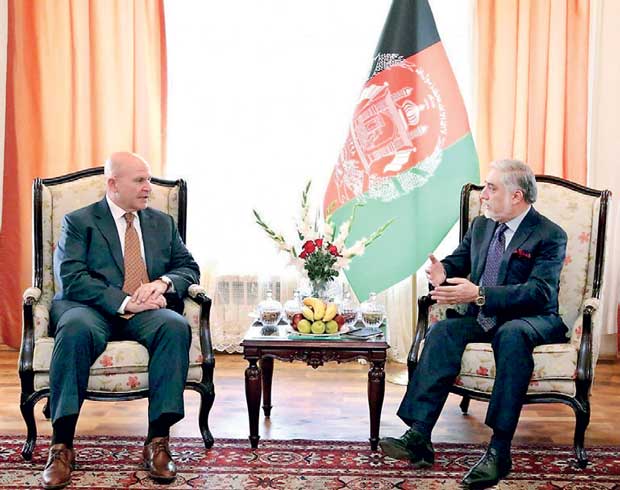10 May 2017 - {{hitsCtrl.values.hits}}

By Missy Ryan, Greg Jaffe · (c) 2017, The Washington Post ·
May 09, 2017 -
President Donald Trump’s most senior military and foreign policy advisers have proposed a major shift in strategy in Afghanistan that would effectively put the United States back on a war footing with the Taliban.
The new plan, which still must be approved by the president, calls for expanding the U.S. military role as part of a broader effort to push an increasingly confident and resurgent Taliban back to the negotiating table, U.S. officials said. The plan comes at the end of a sweeping policy review built around the president’s desire to reverse worsening security in Afghanistan and “start winning” again, said one U.S. official, who like others spoke on the condition of anonymity to discuss internal deliberations.
The new strategy, which has the backing of top Cabinet officials, would authorize the Pentagon, not the White House, to set troop numbers in Afghanistan and give the military far broader authority to use airstrikes to target Taliban militants. It would also lift Obama-era restrictions that limited the mobility of U.S. military advisers on the battlefield.
The net result of the changes would be to reverse moves by President Barack Obama to steadily limit the U.S. military role in Afghanistan, along with the risk to American troops and the cost of the war effort, more than 15 years after U.S. forces first arrived there.
Trump is expected to make a final call on the strategy before a May 25 NATO summit in Brussels that he plans to attend.
Officials said it is unclear whether Trump, who has spoken little about the United States’ longest war, will look favourably upon expanding the U.S. role in Afghanistan. While he has voiced skepticism about allowing U.S. troops to become bogged down in foreign conflicts, the president has also expressed a desire to be tough on terrorism and has seemed to delight in the use of military force.
“The review is an opportunity to send a message that, yes, the U.S. is going to send more troops, but it’s not to achieve a forever military victory,” said Andrew Wilder, an Afghanistan expert at the U.S. Institute of Peace. “Rather, it’s to try to bring about a negotiated end to this conflict.”
The new strategy is a product of the U.S. military’s mounting worries that the fragile stalemate with the Taliban has been steadily eroding for years, jeopardizing the survival of an allied government and endangering a key U.S. base for combating militant groups such as al-Qaida and the Islamic State throughout South Asia. Even as it moves to the president’s desk, the proposal faces resistance from some senior administration officials who fear a repeat of earlier decisions to intensify military efforts that produced only temporary improvements.
Inside the White House, those opposed to the plan have begun to refer derisively to the strategy as “McMaster’s War,” a reference to H.R. McMaster, the president’s national security adviser. The general, who once led anti-corruption efforts in Afghanistan and was one of the architects of President George W. Bush’s troop surge in Iraq, is the driving force behind the new strategy at the White House.
The White House declined to comment.
The plan envisions an increase of at least 3,000 U.S. troops to an existing force of about 8,400. The U.S. force would also be bolstered by requests for matching troops from NATO nations. But, in keeping with the Trump administration’s desire to empower military decision-making, the Pentagon would have final say on troop levels and how those forces are employed on the battlefield. The plan would also increase spending on Afghanistan’s troubled government in an effort to improve its capacity. The additional troops and aid spending would add to the fiscal toll of a war that already costs $23 billion annually, a factor Trump advisers expect will weigh heavily in the president’s consideration of additional military actions.
In a break with the past, U.S. officials said that increases in U.S. troop levels and support to the Afghan government and military would be heavily conditioned on the ability of Afghan President Ashraf Ghani, who heads a fragile unity government, to weed out ineffective military commanders and reduce corruption, both of which have led some aggrieved Afghans to turn to the Taliban as a better alternative.
The question at the heart of the new strategy is whether U.S. and Afghan forces, even if bolstered by new troops and authorities to target the Taliban, can create enough pressure to push the war toward a negotiated settlement. Those opposing the escalation have argued that even the Obama-era surge, which peaked at 100,000, did not result in Taliban concessions in on-again, off-again U.S.-Taliban talks begun in 2011.
17 Nov 2024 2 hours ago
16 Nov 2024 7 hours ago
16 Nov 2024 8 hours ago
16 Nov 2024 8 hours ago
16 Nov 2024 9 hours ago